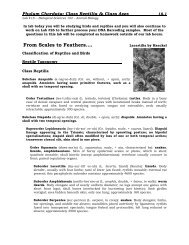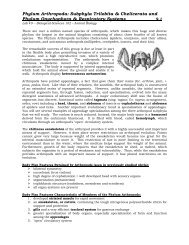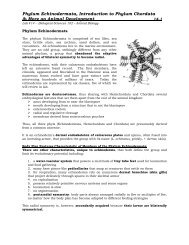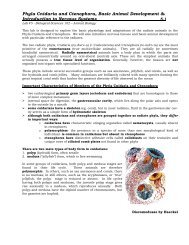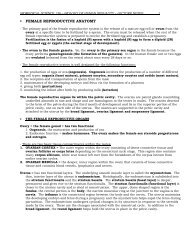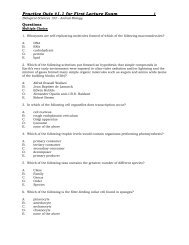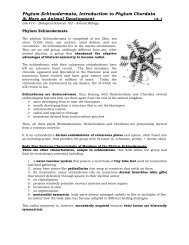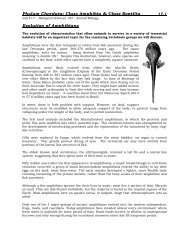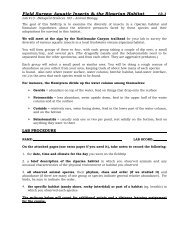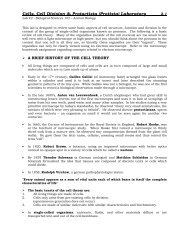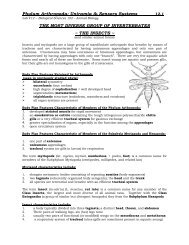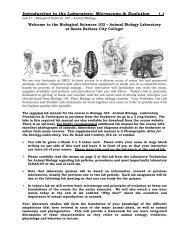Acoelomates: Phylum Platyhelminthes and Nemertea - Biosciweb.net
Acoelomates: Phylum Platyhelminthes and Nemertea - Biosciweb.net
Acoelomates: Phylum Platyhelminthes and Nemertea - Biosciweb.net
Create successful ePaper yourself
Turn your PDF publications into a flip-book with our unique Google optimized e-Paper software.
<strong>Acoelomates</strong>: <strong>Phylum</strong> <strong>Platyhelminthes</strong> <strong>and</strong> <strong>Nemertea</strong> <strong>and</strong><br />
Pseudocoelomates: Phyla Nematoda <strong>and</strong> Rotifera & Parasitism 6.5<br />
Lab #6 - Biological Sciences 102 – Animal Biology<br />
Body Plan Features & Characteristics of Members of the <strong>Phylum</strong> Rotifera<br />
(some of these traits are seen in other animal phyla):<br />
1. bilateral symmetry <strong>and</strong> triploblastic structure (endoderm, mesoderm <strong>and</strong> ectoderm)<br />
2. psuedocoelomate = possess a pseudocoelom<br />
3. some degree of cephalization = head with sensory organs<br />
4. some organ systems (formed of true tissues) are present<br />
5. complete digestive system with mouth <strong>and</strong> anus<br />
6. well muscularized pharynx = mastax that contains trophi (jaws) for sucking <strong>and</strong><br />
grinding food particles<br />
7. ciliated corona helps sweep food particles to mouth<br />
8. pair of protonephridial tubules for osmoregulation & excretion<br />
9. syncitial (multinucleate) epidermis; some have a secreted cuticle<br />
10. longitudinal muscles <strong>and</strong> circular muscles in body wall<br />
11. pedal gl<strong>and</strong>s of foot secrete adhesive material in both sessile <strong>and</strong> creeping forms<br />
12. hydrostatic skeleton (as muscles push against parenchyma <strong>and</strong> tissue fluids)<br />
13. dioecious; sexes separate with females larger than males; one or two tubular gonads;<br />
copulatory spicules present in males; can be parthenogenic<br />
‣ Reproduction in Rotifers<br />
‣ single (male) or double set of gonads (female) <strong>and</strong> ducts in each sex<br />
‣ sexes separate (dioecious)<br />
‣ males unknown in class Bdelloidea <strong>and</strong> only occur a few weeks a year in the class<br />
Monogononta<br />
‣ all females are parthenoge<strong>net</strong>ic in the class Bdelloidea (diploid females produce<br />
diploid females)<br />
‣ parthenogenesis = unisexual reproduction involving the production of young by<br />
females that are not fertilized by males; common in rotifers, aphids, bees, ants <strong>and</strong><br />
wasps. Parthenoge<strong>net</strong>ic eggs may be haploid or diploid.<br />
‣ in the class Monogononta, most of the year, diploid females produce thin shelled<br />
diploid amictic eggs. These amictic eggs develop parthenoge<strong>net</strong>ically into diploid<br />
(amictic) females. When the environment in the pond or stream changes due to<br />
crowding, diet, change in photoperiod, etc. some amictic eggs develop into diploid<br />
mictic females that produce thin shelled haploid eggs. If these eggs are not fertilized<br />
then they will develop into haploid males. If the eggs are fertilized, they become<br />
mictic eggs with a thick, resistant shell <strong>and</strong> become dormant. These “winter eggs”<br />
can survive until the environment becomes more suitable at which time they hatch <strong>and</strong><br />
develop into amictic females (completing the cycle). Females grow <strong>and</strong> reach maturity<br />
in a few days while males rarely grow <strong>and</strong> are mature at birth.



